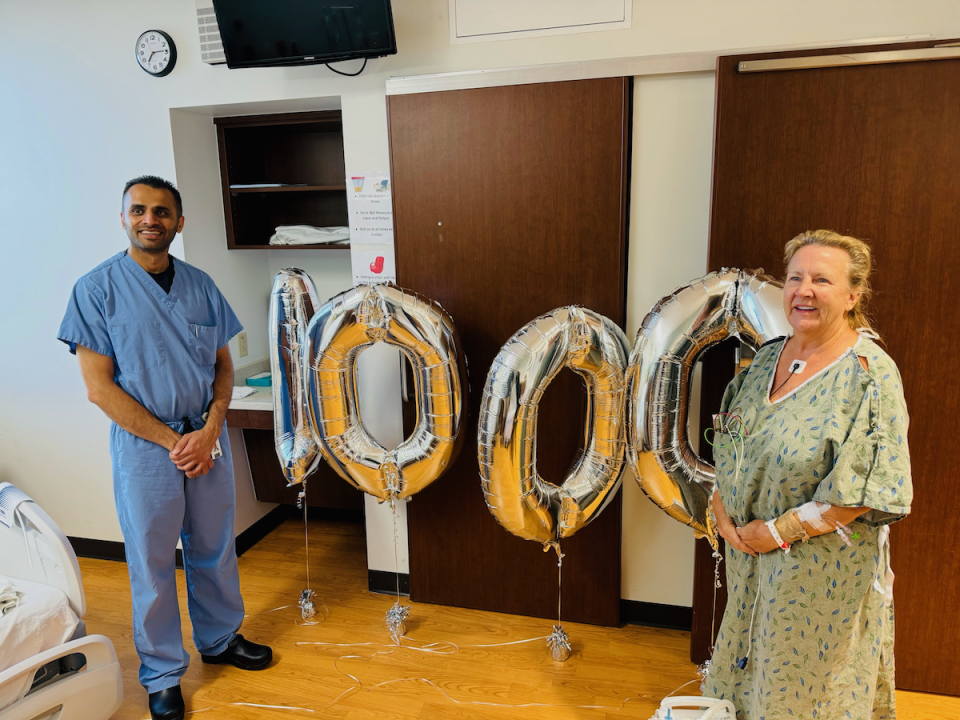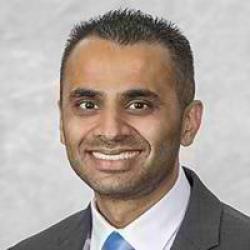After a routine physical with her longtime primary care provider, Kathy S. received a preventative coronary calcium scan to check for calcium deposits in the heart. The good news? Her calcium score was zero. The bad news? The test found an anterior mediastinal mass in her lungs.
“I had two options,” explains Kathy, an active grandmother of five who enjoys playing pickleball and hiking. “I could wait and watch it, or I could have it removed. I didn’t have any symptoms, but back in 2008, I had thyroid cancer. While the likelihood of this being related was small, I didn’t want to take any chances.”
“In Kathy’s case, it’s a short procedure, lasting only about 20 minutes,” explains Dr. Patel. “I make three tiny incisions and go through the side of the chest between the ribs. The robotic instruments give me the ability to work in small spaces and precisely remove the mass.”
Dr. Patel informed Kathy that her surgery would be done robotically and took the time to help her understand what it would entail. She reviewed additional information provided by Dr. Patel and even did some research on her own, including watching videos.
“It was very interesting to me,” shares Kathy. “It was amazing to learn how the procedure works through three small holes, how the mass is put into a bag and removed through one of the holes.”
A quicker return to doing what she loves
Robotic surgery provides many benefits, such as less pain during recovery, a lower risk of infection, reduced blood loss, a shorter stay in the hospital and smaller scars.
“In the past, this type of procedure would require the surgeon to break the breast bone,” explains Dr. Patel. “This translates to a longer surgery with recovery being more difficult and a longer time in the hospital with more activity restrictions. With the robotic option, we’re able to offer Kathy the opportunity to have peace of mind with an easier and shorter recovery.”
Three weeks after her initial appointment and following a hiking trip to visit several national parks in Utah, Kathy had her procedure performed by Dr. Patel. The mass ended up being a benign thymic cyst. As expected, she only has three small holes where the surgery was performed, and she spent one night in the hospital.
“I wanted to get back to doing all of the things that I love as soon as possible as I’m a firm believer that maintaining an active and healthy lifestyle is good for both the body and the mind,” adds Kathy. “I only had restrictions for the first two weeks after surgery. Since the stitches have been removed, I’ve been able to get back to the gym, lifting weights, hiking and playing pickleball. I can’t even imagine what the recovery time would have been like if I’d had surgery using older methods.”
She also makes glowing remarks when speaking about the HonorHealth team.
“Dr. Patel was so personable, a great listener, took time with me and made me feel like I was important,” shares Kathy. “In the hospital, the entire team was very kind. Anytime I needed something or wanted to walk after the procedure, they were always happy to help.”
Peace of mind with robotic surgery
When a small nodule was discovered on her left lung, HonorHealth patient Gretta C. needed to have a biopsy. Thanks to an accurate and less invasive robotic technique, she was able to heal quickly.
In-depth services for thoracic diseases
HonorHealth offers diagnosis and treatment options for thoracic diseases, including lung, esophageal and chest disorders. Our expert team will work with you to determine the best treatment for you.
Smoke of any kind raises your risk
Lung cancer causes more than 135,000 deaths annually in the U.S., making it the deadliest among all cancers. What’s the best way to prevent this deadly cancer? Don’t smoke, and if you do, quit.

